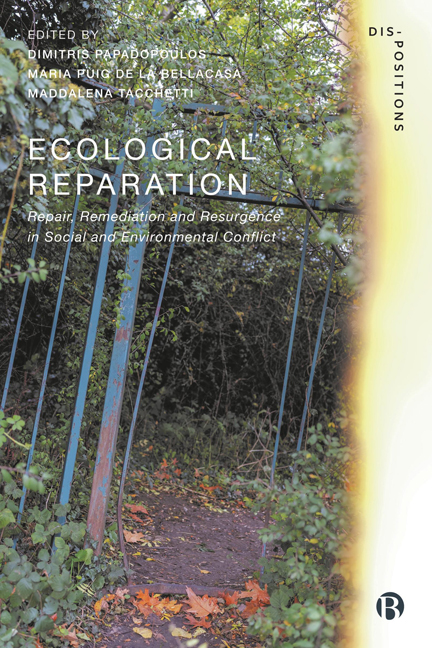Book contents
- Frontmatter
- Contents
- List of Figures
- Notes on Contributors
- Acknowledgements
- Note on the Figures
- Dis-Positions Series Preface
- Introduction: No Justice, No Ecological Peace: The Groundings of Ecological Reparation
- PART I Depletion<>Resurgence
- PART II Deskilling<>Experimenting
- PART III Contaminating<>Cohabiting
- PART IV Enclosing<>Reclaiming Land
- PART V Loss<>Recollecting
- PART VI Representing<>Self-governing
- PART VII Isolating<>Embodying
- PART VIII Growth<>Flourishing
- Index
6 - The Cosmoecological Workshop: Or, How to Philosophize with a Hammer
Published online by Cambridge University Press: 28 March 2024
- Frontmatter
- Contents
- List of Figures
- Notes on Contributors
- Acknowledgements
- Note on the Figures
- Dis-Positions Series Preface
- Introduction: No Justice, No Ecological Peace: The Groundings of Ecological Reparation
- PART I Depletion<>Resurgence
- PART II Deskilling<>Experimenting
- PART III Contaminating<>Cohabiting
- PART IV Enclosing<>Reclaiming Land
- PART V Loss<>Recollecting
- PART VI Representing<>Self-governing
- PART VII Isolating<>Embodying
- PART VIII Growth<>Flourishing
- Index
Summary
Introduction: a metaphysical catastrophe
And suddenly the world began to quake. The ground trembled. Soils liquified under the smooth covers of asphalt. Modern infrastructures were bent, dented, upended. Buildings moved to the rhythm of their crumbling dance. Those inside ran out, when they could. Others succumbed to the collapse. The rumbling noise filled the air. Amidst the turmoil, hundreds of metres of coastline fell off a cosmic cliff, dropping vertically by over half a metre. The Earth itself trembled, shaken, literally knocked off its axis. Days have been shorter ever since. The Pacific Ocean shrivelled a little. And Japan, whose northeastern region of Tohoku was closest to the epicentre, was moved 13 feet closer to North America. With a magnitude of 9,1 Mw, it was the biggest earthquake to have struck the archipelago, and only the fourth most powerful in the history of seismology. And yet it only took six minutes. Six. The planetary blink of an eye, making it present that most things happen in the break, through the cracks, with the tides of time, through the resonance of events: ‘point of view on a point of view, displacements of perspective, differentiation of difference’ (Deleuze, 2004: 200). For indeed, the earthquake that struck northeastern Japan on 11 March 2011 turned out to be but a prelude, a foreshock of its own, a call to another kind of intensity whose response washed it all away. This was what seismologists call an underwater megathrust earthquake – a name that could belong just as well to geology as to poetry – and the 39-metre tsunami that it summoned flooded the entire area, ravaging it all in a 200-square mile range. The dark wave truly devoured everything: almost 20,000 people died, countless other critters saw their lives brought to a sudden end, and over 45,000 buildings were destroyed. Among those who survived, 4.4 million households were left without electricity, over 340,000 people were displaced, and suffered from food, water, shelter, medicine, and fuel shortages for a long period of time afterwards, even when considerable material efforts were deployed to restore infrastructures in the wake.
The tsunami precipitated ripples of its own.
- Type
- Chapter
- Information
- Ecological ReparationRepair, Remediation and Resurgence in Social and Environmental Conflict, pp. 104 - 116Publisher: Bristol University PressPrint publication year: 2023



